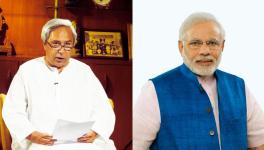India Crossing Grim Milestones of COVID-19 Deaths
India is in the grip of a rapidly unfolding disaster, as daily reported cases and deaths due to COVID-19 continue to set new lows. Several questions arise amid this – didn’t the government know that a terrible second wave of COVID-19 would return to haunt the country? Was the government unaware that if the second wave returned, there could be a huge shortage of oxygen in hospitals of the country?
The answer to these questions, as has been revealed in the past few days, is yes, the government was well aware of the facts in advance. As early as November 2020, the government had been informed about the possible return of the virus. It was also aware of the looming threat of the oxygen crisis across the country.
The Parliamentary Standing Committee on Health, in its report in November 2020, had predicted the ongoing crisis.
On October 16, 2020, the Secretary of the central government’s Department of Health and Family Welfare had submitted to the parliamentary committee all the previous figures on the decline and surge of COVID-19 cases. Analysing the second and third wave of COVID-19 pandemic in the European countries, the committee had estimated that there was a huge risk of rapid spread of the virus across the country.
The Health Department's secretary had also warned the government that COVID-19 cases would grow in the days to come. In the report, the secretary had even termed the upcoming festivals as “super spreading” events. Despite that, two major festivals (Chhath in November 2020 and Holi in March 2021) were celebrated flouting all prescribed precautions in the country.
Also read: Timeline: How Indian Govt Ignored Warnings and Led People into COVID-19 Catastrophe
While people travelled on a large scale ahead of the festivals, the government chose to look the other way, instead busying itself with Assembly elections in several states.
In April, even after the second wave was already here, a sea of people (around 70 lakh) gathered at the Maha Kumbh Mela in Uttarakhand’s Haridwar to take a dip in the holy river of Ganges, making a mockery of all COVID-19 guidelines. This time too, the government was busy in Assembly elections in West Bengal.
Prime Minister Narendra Modi addressed the chief ministers of different states via video conferencing, wearing a mask, but he surprisingly allowed huge crowds to gather in his election rallies without masks in the recently concluded Assembly elections in Bengal.
Likewise, other political parties did the same in poll-bound states such as Assam, Tamil Nadu, Kerala and Puducherry.
Panchayat elections were held in Uttar Pradesh and hundreds of government teachers who were deputed to conduct the polls allegedly contracted the infection and succumbed to the virus.
So, how did the government prepare to deal with the possible threat of the second wave?
The Epidemic Diseases Act, 1897, or Pandemic Act of the central government has been in force in the country for the last one year. The central government could have directed the states to strictly implement the guidelines.
On the contrary, the Uttarakhand government joined the Maha Kumbh event and the ruling Bharatiya Janata Party (BJP) in the Centre and the state even justified it. If the central government had implemented the Standing Committee on Health's report, then the country would not have witnessed the ongoing disaster.
WORSENING OXYGEN CRISIS
Meanwhile, the government has been claiming that there is no shortage of oxygen in the country, but the number of deaths are rising with each passing day. “The judiciary or the executive? I don’t know who is running this country,” said Delhi’s Batra Hospital Medical Director Dr SCL Gupta.
On May 1, 12 COVID-19 patients, including a doctor associated with the hospital’s gastroenterology department, died at Batra Hospital in Delhi allegedly as a result of acute oxygen shortage.
On May 2, 24 patients died allegedly due to fluctuating oxygen supply in hospitals in Karnataka’s Chamarajanagar district.
On May 3, five patients died in Uttar Pradesh’s Meerut district after a private hospital allegedly ran out of oxygen.
On April 18, six COVID-19 patients reportedly died in one night at the ICU ward of Shahdol Medical College in Madhya Pradesh as oxygen ran out.
Also read: Timeline: How Indian Govt Ignored Warnings and Led People into COVID-19 Catastrophe
On April 23, 20 patients infected with by the virus died supposedly because of short supply of oxygen at Jaipur Golden Hospital in Delhi. The hospital needed 3,600 litres of oxygen for the patients, but only 1,500 litres were supplied till 12 midnight. The hospital was to receive its quota of oxygen at 5:30 p.m. that day.
On April 23, Sir Gangaram Hospital, Delhi’s one of the major hospitals, reported a dip in oxygen supply and said that 25 of the most sick patients admitted there died in 24 hours.
These are only some statistics pertaining to deaths of innocents allegedly due to oxygen crisis. Such stories are being reported almost everyday from different states of the country. Many states, including the national capital, are facing shortage of oxygen supply even today.
The situation has turned so grim that the Supreme Court and the Delhi High Court have been forced to intervene. The constitutional courts are reprimanding the Centre in every hearing of the suo moto case, directing it to ensure adequate supply to states as per their allocation.
Not only that, those patients who are in home isolation are reportedly facing the same crisis and many of them are allegedly dying because of oxygen shortage.
Those who are extending a helping hand to the sick people in hospitals and at homes are claiming that they are flooded with SOS calls, seeking oxygen cylinders, refills, hospital beds, injections, medicines, etc.
Further, there are no records of patients who have died at their homes allegedly because of the oxygen crisis.
GOVERNMENT INFORMED ABOUT OXYGEN CRISIS
The health secretary of the Department of Health and Family Welfare had informed the Parliamentary Standing Committee on Health on October 16 last year that “hospitals are using oxygen on large scale” and therefore, “the consumption of oxygen is increasing”.
The overall production of medical oxygen in the country pre-COVID-19 stood roughly at 6,900 MT every day. During the time, the consumption of medical oxygen was almost 1,000 MT per day and the rest was used in industry.
During the first wave of the virus outbreak, the oxygen demand of hospitals had tripled. The highest consumption of medical oxygen was reported in mid-September last year and around September 24- 25, it went up to 3,000 MT a day.
Considering this, the standing committee had told the government that the second wave was yet to come and therefore, there is a strong need to ensure that the oxygen inventory is in place and oxygen prices are controlled.
Also read: Modi Govt vs COVID: A Shambolic Fight
The committee had agreed with the department that the pandemic has led to an unprecedented increase in the demand of non-invasive oxygen cylinders and instances of lack of oxygen cylinders in hospitals had also been reported.
It, therefore, had strongly advocated for the National Pharmaceutical Pricing Authority to take appropriate measures for capping the prices of oxygen cylinders so that the availability as well as affordability of oxygen cylinders is ensured in all hospitals for medical consumption.
The committee had also recommended the government for encouraging adequate production of oxygen for ensuring its supply as per demand in hospitals.
While the production of oxygen has not gone down, at still over 7,200 MT every day, nearly 90% of the total production is now being used for hospitals and other medical needs against the previous demand of 10%.
But then, why this crisis?
Since the Pandemic Act is in place, the Centre is vested with the power to make allocations for every state as per their requirements of medical oxygen.
However, its transportation to hospitals across the country has reportedly not been worked out. The central government had to develop a network system to transport the required oxygen to different states of the country. But the government did not do when it had enough time for such preparations to fight this wave.
So far, medical oxygen was transported by road only in cryogenic tankers. These oxygen tankers often have to stand for hours outside the oxygen production plant because it takes about two hours to fill a tanker.
There is a speed limit (40 km/hour) for these tankers to ply on road. They do not ply at night to avoid accidents. It is obvious that the demand-supply gap cannot be met at a time when demands are high by tankers reaching the hospitals via road.
When the situation got out of hand, the government decided to run the Oxygen Express on April 18 to transport oxygen to hospitals. But it was too late. By then, the country had begun reporting 2.75 lakh cases daily.
The Union Health Ministry had invited bids in October last year to set up oxygen plants across the country. By then, it had been more than eight months since the COVID-19 virus had spread its tentacles in India. Several proposals for setting up of oxygen plants came, and 162 were approved. But only 30 plants have been made operational so far.
This indicates that the absence of emergency planning to deal with any kind of shortage of medical oxygen seems to main the reason behind the ongoing crisis.
Get the latest reports & analysis with people's perspective on Protests, movements & deep analytical videos, discussions of the current affairs in your Telegram app. Subscribe to NewsClick's Telegram channel & get Real-Time updates on stories, as they get published on our website.























